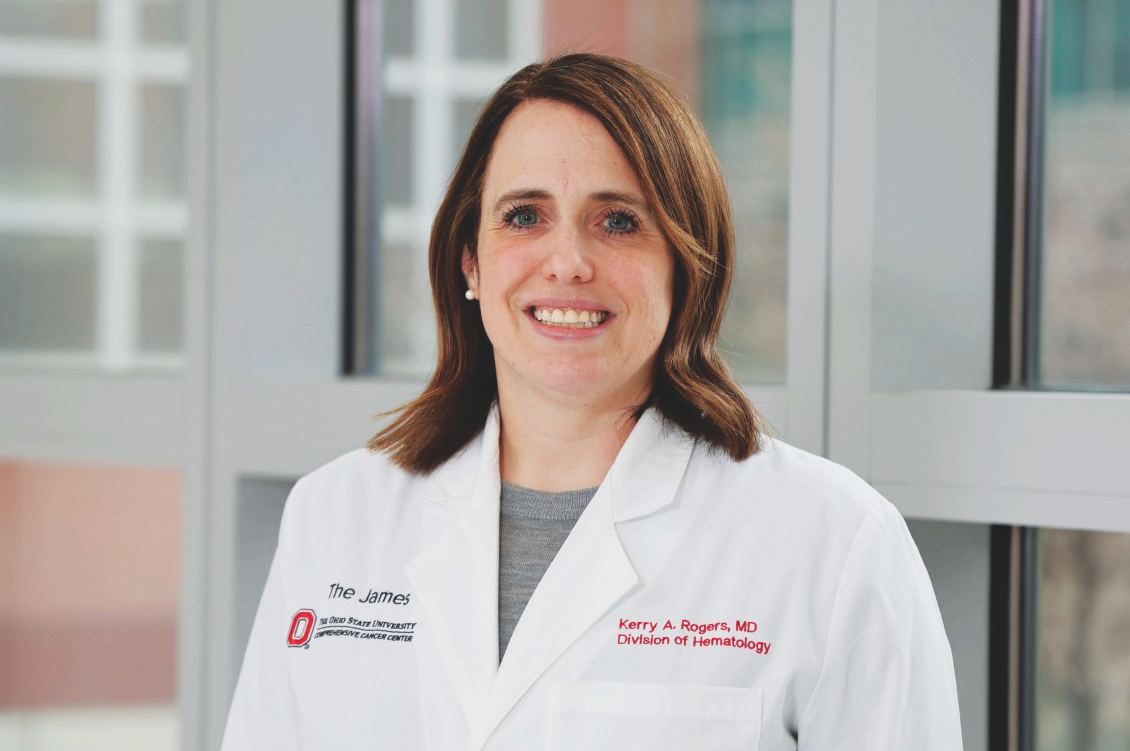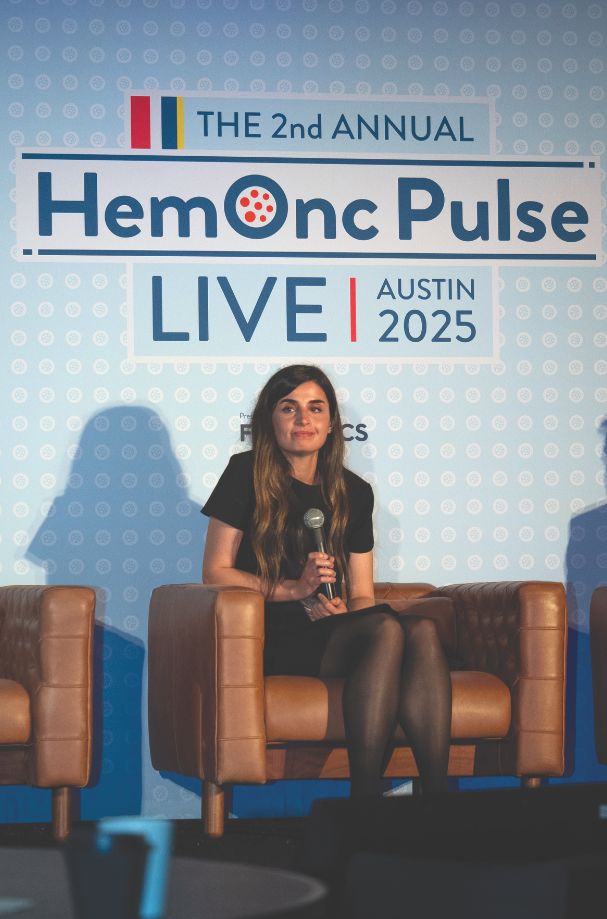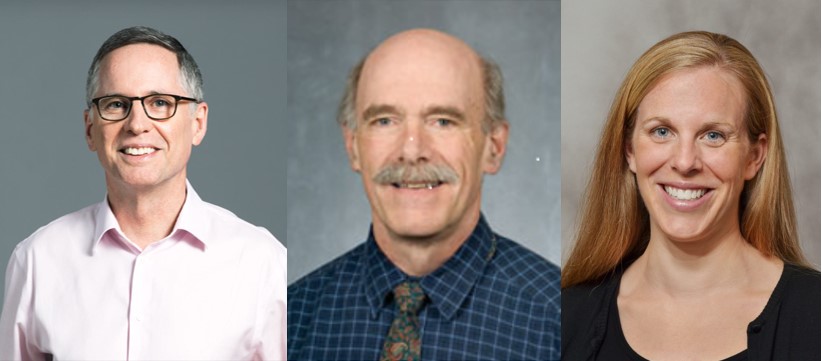
Manali Kamdar, MD, Associate Professor of Medicine-Hematology at the University of Colorado Medicine, and Craig S. Sauter, MD, FACP, Director of the Blood and Marrow Transplant Program at the Cleveland Clinic, debate whether chimeric antigen receptor (CAR) T-cell therapy or autologous hematopoietic stem cell transplantation (AHSCT) are optimal second-line treatment options in relapsed/refractory diffuse large B-cell lymphoma (DLBCL).
Dr. Kamdar: The pivotal studies were all phase II, single-arm studies—TRANSCEND, BELINDA, and ZUMA-1. Based on those studies, the constructs—namely, lisocabtagene maraleucel, tisagenlecleucel, and axicabtagene ciloleucel—became U.S. Food and Drug Administration (FDA)-approved in the third-line setting for relapsed aggressive B-cell non-Hodgkin lymphomas (NHLs) based on the overall response rate (ORR), complete response (CR), and progression-free survival (PFS). Some of these studies now have a follow-up of up to four years demonstrating that nearly 40% of patients who would have otherwise succumbed to their disease continue to be in remission. We still use the word “cure” with a little bit of restraint, but at the four-year mark, about 40% of patients who had previously failed two lines of treatment or an autologous transplant continue to do well after CAR T-cell therapy. The next step was to test CAR T-cell therapies in the earlier lines of treatment, and the most intuitive space with the highest unmet need was in the second-line high-risk relapsed/refractory setting.
For nearly three decades, the standard of care for fit patients with relapsed or refractory large B-cell NHL after failure of frontline chemoimmunotherapy has been salvage chemotherapy followed by an autologous transplant. Although curative in a subset of patients, prospective studies such as the CORAL and NCIC-LY.12 trials and recent SCHOLAR-1 meta-analyses have shown that patients who are primary refractory or relapsed within 12 months after frontline therapy have extremely dismal outcomes, with most studies showing that only a quarter of these transplant-intended patients achieve durable remissions. Thus, CAR T-cell therapy was the perfect space, in my opinion, to test against the three-
decade-old standard of care.
The pivotal phase III studies, namely ZUMA-7, TRANSFORM, and BELINDA, randomized patients with high-risk large-cell NHL to receive standard of care versus CAR T-cell therapy. The primary endpoint was event-free survival (EFS), which was met and statistically significant in ZUMA-7 and TRANSFORM. Other secondary endpoints such as ORR/CR/PFS, including patient-reported outcomes, were also statistically significant and superior in the CAR-T arm compared with standard of care. CAR-T-related unique side effects, cytokine release syndrome (CRS) and neurotoxicity, were manageable, with TRANSFORM showing decreased high-grade CRS and neurotoxicity compared with ZUMA-7. At this point, patients continue to do well on CAR T-cell therapy. They certainly can have unique side effects, such as CRS and neurological toxicity, which were very manageable. It is important to mention that in the TRANSFORM study, grade 4 or 5 CRS and immune effector cell-associated neurotoxicity syndrome was zero. It is not only an efficacious option, but it’s also an extremely well-tolerated option. BELINDA was a negative study; there are many reasons for why that could be hypothesized. The ZUMA-7 study has the longest follow-up thus far, and patients on the CAR-T arm continue to do well.
Given the excellent positive results of these two pivotal trials, I do believe that CAR T-cell therapy should be the standard of care for patients with high-risk relapsed/refractory DLBCL. I would go a step further and say that these immunotherapies need to be explored even in the earlier higher-risk settings. At this time, however, I do think there is a subset of patients in whom AHSCT may continue to be the standard of care. These might be those who are chemosensitive with a partial response (PR) or patients who relapse more than 12 months out. Whether CAR T-cell therapy would be better for this subset of patients could only be explored within the context of a clinical trial.
Dr. Sauter: I do not disagree with Dr. Kamdar. I have the unenviable task of defending autologous transplant in the second-line setting. As Dr. Kamdar nicely explained, there have recently been readouts of three prospective, randomized, phase III studies looking at previous standard of care, which was platinum-based, salvage chemotherapy followed by AHSCT in patients who achieve what is defined as a chemotherapy-sensitive response—either a PR or complete remission to the aforementioned platinum-based salvage chemotherapy—versus CAR-modified T-cell, per study. ZUMA-7, which has the longest follow-up, studied axicabtagene ciloleucel, BELINDA studied tisagenlecleucel, and TRANSFORM evaluated lisocabtagene maraleucel.
These studies enrolled patients with either primary refractory disease to R-CHOP (rituximab, cyclophosphamide, doxorubicin, vincristine, and prednisone)-like chemotherapy induction or relapse within 12 months of diagnosis. It should be noted that within the three studies, the majority of patients were primary chemotherapy-refractory who were not achieving a complete metabolic response to initial induction therapy. Two of the studies were positive for the primary endpoint of EFS, including, notably, an overall survival (OS)
benefit in the TRANSFORM study, as well as long-term follow-up in the ZUMA-7 study without OS benefit. There are a few caveats to the phase III studies that I think need to be highlighted. The first is that the vast majority of patients were primary refractory to initial induction strategies. I believe
the relapse cases are not well represented in these studies, and it would not be a deviation from a
standard to pursue salvage chemotherapy in a patient who achieves a CR to initial induction therapy with a relapse that may occur within 12 months of diagnosis of their large-cell lymphoma.
Another caveat from the TRANSFORM study is that the first interim restaging was determined by the investigator and was not centrally reviewed by a radiologist on study in a blinded fashion. Thus, switching lymphoma therapy to the CAR T-cell or other optimal therapy—as there was not a formal crossover to CAR T-cell from standard therapy—was determined by the investigator. In a subsequent analysis and what has been presented in the supplemental material of the ZUMA-7 publication in The New England Journal of Medicine was that while investigators determined that chemotherapy sensitivity was met in 80 patients in the standard-of-care arm, in a subsequent retrospective, centralized review by study radiologists, 90 of the subjects actually achieved an adequate response that would be permissive to proceed to an autologous transplant. Within that arm of ZUMA-7, it’s of curious interest that a large fraction of patients with chemosensitivity to salvage therapy did not proceed to autologous transplant.
That percentage approached 30%, meaning of the patients who responded to platinum-containing salvage chemotherapy, 30% did not proceed to consolidation with autologous transplant, which was somewhat striking in practice. Typically, when patients are responding to chemotherapy, in practice, we are typically able to complete the consolidation with autologous transplant. Previous large, randomized, phase III studies, including CORAL, ORCHARD, and NCIC-CTG LY.12, had drop-off rates of patients who responded to salvage chemotherapy of 20% or less. I would like to highlight that it’s also conspicuous that the vast majority of patients enrolled in the ZUMA-7 study were of germinal-center phenotype, where a typical cell of origin for a relapsed/refractory patient population is non-germinal-center phenotype. It introduces the question of whether there were better-risk patients who were enrolled in ZUMA-7 and ultimately proceeding to CAR-modified T-cell therapy.
Again, I would like to highlight that while it met the primary EFS endpoint with adequate follow-up, there was no OS benefit on the ZUMA-7 study. The other positive study, the TRANSFORM study, had shorter follow-up. The majority of patients are primary refractory to initial induction chemotherapy and are not relapsed. I would contend that the patient group is not well represented in these randomized, phase III studies. As we know, that access to CAR-modified T-cell therapy, in terms of timing of the procedure, the requisite apheresis, getting to a center can be a major hurdle. There was a 21% screen failure rate on the TRANSFORM study due to the lack of apheresis slots on the study. I think this speaks to the limited access to this therapy, and access issues are currently being dealt with in our practice community, particularly with products for multiple myeloma.
The ability to make an autologous product for each patient in a timely fashion is a major factor at this point. Despite having a prospective, randomized clinical study with eligible subjects, there was still a one-out-of-five dropout rate because of lack of an apheresis spot on TRANSFORM. I think that needs to be contended with, despite the fact that the TRANSFORM study was positive for a primary EFS endpoint and actually demonstrated an OS benefit, per the recently peer-reviewed publication by Dr. Kamdar. The third study, BELINDA, was another randomized, phase III study of standard of care versus CAR-modified T-cells, and it was negative. That study design was somewhat different than the other two necessitating second salvage in the standard-of-care arm to determine failure.
There were significant delays to apheresis and manufacturing of the product on the experimental arm of BELINDA, with an average time to return a product of more than six weeks. Clearly that was not an effective strategy and that resulted, or likely contributed to, a negative study with equal EFS and OS in the two arms. With those caveats, I do not dispute the FDA approval of the two products, lisocabtagene maraleucel and axicabtagene ciloleucel, for treatment in the second-line setting. I would emphasize within practice, particularly for the primary refractory patients, I think previous standard of care should be a consideration for patients who achieve a complete remission to initial induction therapy who have a relapse, even if it is a somewhat short time from completion of induction chemotherapy for consideration of platinum-based salvage, particularly if that’s on an optimized, or an intended-to-be optimized, program on a clinical study of a targeted agent plus a platinum-based backbone.
I would like to defend autologous transplant. We don’t know what a patient is going to look like following failure of CAR-modified T-cells in the second-line setting, in terms of being able to tolerate combination chemotherapy and autologous transplant. Some unknowns include previous exposure to fludarabine and the ability to collect hematopoietic progenitor cells for said transplant and whether they will be able to tolerate chemotherapy following failure of CAR-modified T-cells, as we know that prolonged cytopenias can remain an issue, particularly for higher-risk cases.
Dr. Kamdar: I do agree with Dr. Sauter. On the ZUMA-7 study, the long-term follow-up did show that about 16% of patients who received standard of care continue to be in remission, which meant nearly 84% of patients had to undergo autologous transplant without a meaningful benefit, however, at the cost of toxicity. I think the biggest challenge is identifying chemosensitivity at diagnosis—to really be able to tell which of these primary refractory or high-risk relapse DLBCL patients are going to be chemosensitive.
While we don’t have those predictive tools to put every single patient through an autologous transplant, to be able to demonstrate chemosensitivity, I do believe that puts the T-cells at risk; the T-cell health gets compromised. On the TRANSFORM study, since crossover was permitted on protocol, we also do know that for patients who received CAR T-cells in the third-line setting, their EFS was actually very similar to patients who received standard of care that is inferior in comparison to getting CAR T-cells in the second-line setting. I think getting CAR T-cell sooner, with all the caveats Dr. Sauter mentioned, would still be something that I would highly consider.
Dr. Sauter: It should be emphasized that the apheresis happened before standard therapy in the TRANSFORM study, which may have influenced T-cell fitness at crossover. Personally, I believe that, in practice, primary refractory disease defines chemotherapy insensitivity. We give our best drugs upfront, including anthracycline-containing combinations of chemoimmunotherapy. Clearly those patients should be identified for CAR-modified T-cells per the two FDA labels. My argument for the sake of debate would be the consideration, if a patient actually achieved a CR, there may be still salvageability with an autologous transplant, which may be more accessible.
Particularly, if patients achieve at least a PR, we know that at least 45% to 50% of patients can be cured with that strategy. For patients who achieve a CR to salvage chemotherapy, the cure fraction is likely greater than 70%. Otherwise, I do support the labels, and I applaud the investigators on the two studies. I think access may become an issue in the second-line setting. I’m hoping that the manufacturers of these products are prepared for a larger volume of patients in the future.
Dr. Kamdar: I think if there’s a randomized, phase III study that demonstrates CAR-T is better than autologous transplant in patients who relapse more than 12 months out, it would strengthen CAR-T as the standard of care for all who relapse at the second line.
Dr. Sauter: I firmly agree with that because that would put to rest my argument that those patients were not well represented that actually achieved a CR to initial induction therapy. I fully support that. I think a point that will strengthen my side of the argument is if we find that there are major access issues to timely CAR-modified T-cell therapy, particularly for sick primary refractory patients. I hope that we get there. As somebody who historically has studied salvage chemotherapy in this setting, it should be noted that all the arms on these studies were standard salvage chemotherapy, and we have not really moved that bar with those combination chemotherapy regimens since it has been a standard of care for 30-plus years. Those studies are difficult to do. They require lots of patients. Now that we are in the era where CAR-modified T-cells are a standard within the second-line setting, it’s going to be even more difficult to conduct studies of optimizing salvage chemotherapy regimens for patients with relapsed/refractory large-cell lymphoma.






 © 2025 Mashup Media, LLC, a Formedics Property. All Rights Reserved.
© 2025 Mashup Media, LLC, a Formedics Property. All Rights Reserved.